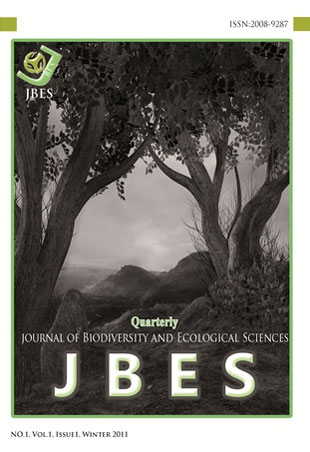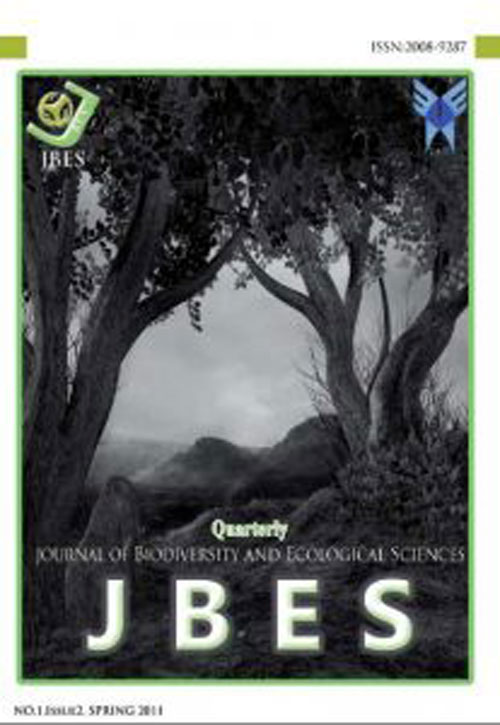فهرست مطالب

Journal of Biodiversity and Ecological Sciences
Volume:1 Issue: 1, 2011
- تاریخ انتشار: 1389/11/16
- تعداد عناوین: 8
-
Page 21The chemical composition of Thymus pannonicus L. and Perovskia atriplicifolia Benth. volatile oils and their antimicrobial activity were studied. Volatile oils of the aerial parts of the plant were obtained by hidrodistilation and analyzed using GC-MS. Antimicrobial activity was evaluated for the volatile oils and for their main components. Our study indicates that the volatile oils of these species have considerable antimicrobial activity deserving further investigation for clinical application.
-
Page 29The emission of air pollutants mainly from anthropogenic sources has led to the degradation of air quality. These pollutants determine the occurrence or worsening of respiratory disorders. Biomonitoring provides information on the quality of the environment or its modifications, having been used as an alternative to monitoring of chemical pollutants. The variation of the biodiversity of lichens can be used as a warning to check if other biological systems are being affected by atmospheric pollution. Lichens have been used as bioindicators, since they have differential sensitivity to air pollution. The purpose of this study was to assess the diversity and abundance of lichens in different zones of the Porto (North Portugal) with respect to the rates of atmospheric pollutants. Three zones were selected for sampling, represented by urban, suburban and rural zones. LDV was calculated for each zone. The average concentrations of CO, CO2, SO2, NO2, O3 and PM10 were also measured. The most sensitive lichens were present in the area with the highest LDV. In places where there were higher concentrations of pollutants, namely NO2 and SO2 a lower LDV. This study suggests that lichens can be used as prevention systems to protect public health, in particular diseases related to air pollution and as a potential alternative or complement to expensive chemical monitoring equipment.
-
Page 41The use of vegetation indices of remote sensing data in vegetation mapping has been long recognised. However, the accuracy of mapping through the use of vegetation indices model has limitations, and has so far not been investigated. This study analysed the performance of the several intrinsic-based vegetation indices (Normalized Difference Vegetation Index-NDVI and Ratio Vegetation Index- RVI) and soil line-based vegetation indices (Perpendicular Vegetation Index-PVI, Soil-Adjusted Vegetation Index-SAVI and Modified Soil-Adjusted Vegetation Index-MSAVI) for mangrove mapping in Kelantan Delta, Malaysia. Landsat TM was used as a primary data set to derive mangrove vegetation class from five vegetation indices model. A total of five mangrove classes consisting of Avicennia-Sonneratia, Avicennia, Acanthus-Sonneratia, Mixed-Acrostichum and Mixed Sonneratia with accuracy 72.67% were determined from unsupervised classification. Then the models were applied on classified image, resulting in mangrove classes which were mapped into three and four classes, respectively. The performance of each VI’s was analysed in accuracy assessment. The accuracy assessment of vegetation indices were ranged from 69.17% to 79.14%. The results revealed that the SAVI was the better performance discriminate mangrove class amongst the four classes compared to others indices with accuracy 79.14%. It might be due to sensitiveness of SAVI model in discriminating the full range of vegetation covers in muddy area. The capability of Landsat TM in mapping mangrove in this study using VI’s models showed the better result, However, the performance of VI’s need to be further investigated for specific use of mangrove resources. This is important where accurate information on mangrove biodiversity status in all habitat level is needed for conservation and monitoring towards achieving sustainable development to the country.
-
Page 53Drastic deforestation is a major problem of Bangladesh which is contributing to negative downstream impacts on the environment. To address this problem various measures should be taken at different scales. The main objective of this paper is to suggest the possible steps that Bangladesh could take and reverse the trend of deforestation. An extensive literature review and interviews with government officials, professionals and NGO workers have been used to collect relevant information on the agents of deforestation in the country. Based on the information gathered, this paper presents the reasons for the extent of deforestation, and suggests some positive steps where the Government could be the main mitigating actor by implementing integrated programmes, which will also ensure mass awareness and wider impact. Local NGOs and international bodies must also formulate adequate plans to protect valuable areas of remaining forest.
-
Page 65In order to study the effects of some environmental variables on the quantitative and qualitative characteristics of Large-leaved lime (Tilia platyphyllos Scop.) in the forests of western parts of Mazandaran province in the north of Iran, 9 experimental sites have been selected. Approach: Within each site, three elevations have been identified. Moreover, each selected site covers three plots with an area of 1 ha (100×100 m). In totally 27 plots have been chosen study.ResultsThe results of the study on the areas under investigation indicate that Large-leaved lime extends in a wide range of environmental conditions. This species is distributed from low elevation to high ones and in different slopes; especially northern, eastern and northeastern ones. The results also show that Large-leaved lime grows in semi-deep to shallow soils with a medium amount of nutrients contents. The soil texture of most sites is clay and clay-silt with pH varying between 5.9 and 7.6.ConclusionsThe results demonstrate that because of being affected by environmental variables, the quantitative and qualitative characteristics played an important role on the site stratification. In this study, it has been observed that ecological factors such as soil, climate, altitude and slope sides have some effects on both quantitative characteristics of Large-leaved lime (diameter at breast height, diameter of crown, total height and height of first branch, as well as height of bi-branch) and qualitative characteristics (stem bending, convolution, as well as symmetry of crown).
-
Page 77Urban forests have played important roles in social, cultural, economic and environmental development of urban centers in West Africa through benefits such as landscape enhancement, provision of recreational and cultural facilities, erosion control, watershed protection and supply of fruits and fuelwood. The growing population and rapid urbanization occasioned by demographic switch from rural to urban society is outstripping the planning and carrying capacity of municipal authorities in West Africa. West African population increased from 132.2 million in 1980 to 234.0 million in 2000 and projected to attain 344.0 million by 2020. This study assessed development of urban forestry, evaluated the effect of population growth on urban forests landscape and designed innovative strategies that will ensure sustainability and improvement of urban living environment. Urban forestry development was investigated through secondary data, directed enquiries to relevant stakeholders, on-the-spot assessment and observations of urban and peri-urban forest facilities in selected West African cities. The result revealed that numerous environmental and material benefits are derived from urban forests in West Africa. The types of tree species planted for landscape enhancement, environmental protection and other benefits varied with ecological zones and cultural values. In Sahel savannah, the preponderance of Adansonia digitata, and Acacia species were observed while in Guinea and Sudan savannah, Azadirachta species, Eucalyptus species, Acacia species and Gmelina arborea dominated. Terminalia species, Gmelina arborea, Tectona grandis, Delonix regia, species of palm, etc were common in tropical rainforest zone. Rapid urban population growth, limited land area, and poor implementation of government policies are some factors affecting urban forests development in West Africa. To ensure sustainable development, forest management technique that accommodates human, social, political, cultural and economic factors should be adopted. Political goodwill should be secured while appropriate social awareness should be promoted to guarantee that forest initiatives are upheld.
-
Page 95Bamni sub watershed is one of the important watersheds at Hasdeo river basin in central India. It covers 1567.09 sq km area and is situated between 680-716 m elevations. IRS 1-D LISS III image analysis of October, 2008 of sub watershed shows that the catchment has a total 25.58% land cover as dense forest, 23.19% is open forest, 34.20% is non forest, 0.59% is scrubland and 16.44% is water bodies. The catchment of Bamni sub watershed is dominated by Sal forest which entail Sal Forest (278.30 km2), Sal Mixed forest (53.49 km2), Mixed Miscellaneous forest (55.36 km2), Dry Deciduous forest (9.59 km2) and Teak forest (4.24 km2). Under the catchment of this sub watershed area agriculture land without crop has been recorded 53.85% and agriculture land with crop has been 46.15%. The local population settlement of the catchment is distributed very unevenly. The whole Bamni area shows a pattern of sustainable utilization of the natural resources.


